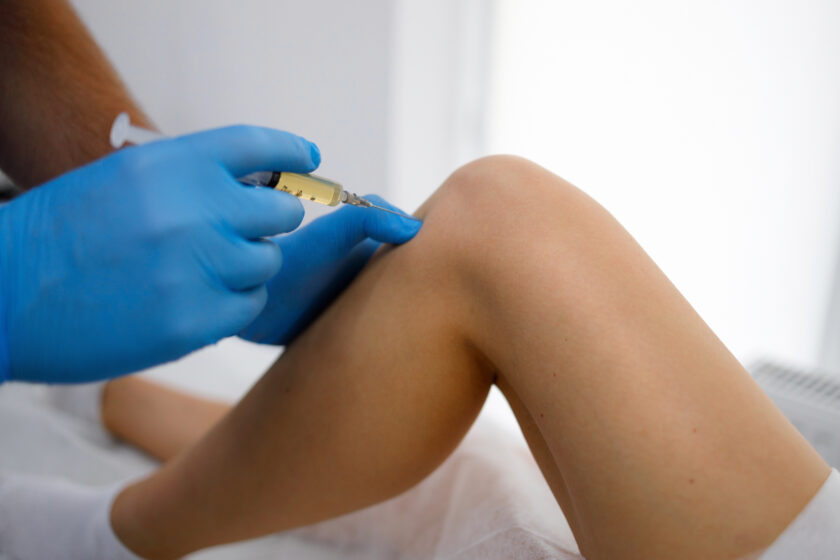Uszkodzenie łąkotki/chrząstki
BCM
12 marca 2024

Łąkotka: w kolanie znajdują się dwie łąkotki-boczna i przyśrodkowa. Są to elastyczne struktury w kształcie litery „C”, znajdujące się pomiędzy powierzchnią stawową piszczeli i uda. Ich główną rolą jest amortyzacja przeciążeń, na które narażone jest kolano podczas aktywności fizycznej. Pomagają też zachować płynność i stabilność ruchów w stawie. Niestety uszkodzenie łąkotki i uskodzenie chrząstki stawowej zdarza się.
Chrząstka
Końce kości udowej i piszczelowej oraz powierzchnia stawowa rzepki pokryte są tzw. chrząstką szklistą-gładką i elastyczną tkanką. Minimalizuje ona tarcie podczas ruchu oraz zapewnia amortyzację, przez co ruchy w stawie są bezbolesne.
Uszkodzenie łąkotki – przyczyny
Obie wyżej wymienione struktury mogą ulec uszkodzeniu, które dzielimy na tzw. „ostre” oraz przewlekłe.
Uszkodzenia ostre
Uszkodzenia ostre łąkotki najczęściej są wynikiem bezpośredniego urazu, do którego dochodzi podczas aktywności fizycznej. Sportowcy, szczególnie ci uprawiający dyscypliny z wysokim ryzykiem kontaktu fizycznego (takie jak piłka nożna, koszykówka, narciarstwo) lub wymagające gwałtownych zmian kierunku i skoków (np. tenis, siatkówka), są szczególnie narażeni na tego typu kontuzje. Mechanizm urazu często obejmuje skręcenie kolana przy jednoczesnym obciążeniu, co prowadzi do pęknięcia lub rozerwania łąkotki.
Przewlekłe uszkodzenia
Z kolei przewlekłe uszkodzenia łąkotki rozwijają się stopniowo, będąc efektem długotrwałych przeciążeń lub degeneracyjnych zmian w strukturze tkanek. Czynnikiem przyczyniającym się do tego typu uszkodzeń jest często choroba zwyrodnieniowa stawów, która prowadzi do stopniowego niszczenia łąkotki i innych struktur stawu kolanowego. Przewlekłe przeciążenia mogą również wynikać z nieprawidłowej biomechaniki ciała, nadwagi, czy też z uprawiania sportu bez odpowiedniego przygotowania fizycznego lub techniki.
Czynniki ryzyka
Do czynników ryzyka uszkodzenia łąkotki należą:
- wiek – z wiekiem tkanka łąkotki staje się mniej elastyczna i bardziej podatna na uszkodzenia
- płeć – badania wskazują, że w niektórych sportach kobiety są bardziej narażone na urazy łąkotki niż mężczyźni, co może być związane z różnicami w anatomii i hormonach
- nadwaga – dodatkowe kilogramy zwiększają obciążenie stawów, co może przyczyniać się do szybszego zużycia łąkotki
- nieprawidłowa biomechanika – nieprawidłowe ustawienie stóp i kolan, słabe mięśnie stabilizujące staw kolanowy mogą prowadzić do nienaturalnego obciążenia łąkotki
Uszkodzenie łąkotki objawy
Uszkodzenie łąkotki może dawać dolegliwości bólowe, np. podczas zginania i prostowania kolana. Mogą też powodować objawy mechaniczne, takie jak: uczucie przeskakiwania, strzelania w kolanie, aż do zablokowania ruchomości stawu. Wyżej wymienionym objawom może towarzyszyć obrzęk stawu.
Uszkodzenie chrząstki stawowej może dawać podobne objawy, dominującym objawem bywa tutaj ból, który zależy również od ewentualnych uszkodzeń innych struktur stawowych.
Diagnoza
Wstępną diagnozę często stawia się już po zebraniu wywiadu i badaniu klinicznym stawu, a potwierdza się ją poprzez badanie diagnostyczne – rezonans magnetyczny stawu kolanowego.
Uszkodzenie łąkotki – leczenie
Uszkodzenie chrząstki stawowej oraz uszkodzenie łąkotki leczy się zależnie od formy ich uszkodzenia (ostre vs. przewlekłe), rozległości oraz uszkodzeń innych struktur stawu kolanowego. Niewielkie uszkodzenia można leczyć zachowawczo – po ustaniu ostrych objawów wdrażana jest rehabilitacja. Przy większych uszkodzeniach bywa, że niezbędna jest operacja.
Rodzaj operacji
Uszkodzenie łąkotki wymaga często naprawy przez wykonanie operacji. Zabieg przeprowadzany jest artroskopowo. Zazwyczaj wykonuje się 2 nacięcia-porty artroskopowe z przodu kolana. Podczas operacji ortopeda potwierdza wstępną diagnozę, bada wszystkie struktury stawu pod kątem innych uszkodzeń. Po wnikliwej ocenie śródoperacyjnej lekarz przechodzi do kolejnego etapu operacji.
Uszkodzenie łąkotki zazwyczaj zaopatruje się albo przez zeszycie uszkodzonego fragmentu, albo usunięcie go. Decyduje o tym wiele czynników, przede wszystkim rozległość i umiejscowienie uszkodzenia. Zastosowane mogą też być przeszczepy łąkotek – ta metoda jest wciąż młoda, choć w perspektywie przyszłości pokłada się w niej duże nadzieje.
Uszkodzenie chrząstki stawowej również leczy się zależnie od tego, jak jest rozległe uszkodzenie – ostateczna decyzja jest zawsze śródoperacyjna, po dokładnej analizie stawu. Dostępnymi metodami są m.in. „debridement”, czyli „oczyszczenie” uszkodzonego fragmentu, „mikrofrakturacje”, czyli pobudzenie tkanki w miejscu uszkodzenia do wytworzenia funkcjonalnej „blizny”. Możliwe są również metody polegające na przeszczepie chrząstki lub uzupełnieniu ubytków matrycami biologicznymi.
Okres pooperacyjny
Następnego dnia po operacji, w większości przypadków, usuwane są dreny, a pacjent wstaje z łóżka z pomocą kul łokciowych. Postępowanie pooperacyjne uzależnione jest od metody leczenia, jaka została zastosowana. Operowana noga zazwyczaj nie wymaga unieruchomienia, wręcz przeciwnie szybki powrót do funkcjonalności jest kluczową kwestią w powrocie do pełnej sprawności. Jeżeli wszystko jest w porządku, pacjent opuszcza szpital. Po wypisie należy jak najwcześniej rozpocząć rehabilitację.
Uszkodzenie łąkotki i uszkodzenie chrząstki stawowej w Szpitalu Zakonu Bonifratrów leczy się artroskopowo. Zabieg wykonuje zespół specjalistów w dziedzinie ortopedii i traumatologii:
- lek. Stanisław Szymanik – Kierownik Oddziału Diagnostyczno-Leczniczego
- lek. Michał Latos
- lek. Michał Starmach

